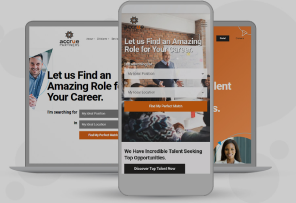Anyone who has built and launched a website has likely encountered an oft-repeated acronym: SEO (search engine optimization). And while you might not have ever done SEO yourself, you've benefited from it in the past: Every day, search engines like Google employ complex algorithms to sift through more than 400 billion web pages and deliver the most relevant results.
Website owners like you use SEO techniques and strategies to get their websites to the top of the search results for relevant user queries. But SEO is not a one-time endeavor — Google and other search engines change often, and ongoing SEO ensures your website stays in front of the people you want to reach. Just as a physical storefront requires regular maintenance and updates to stay competitive, your website needs ongoing SEO to remain visible amidst the ever-changing digital landscape.
The ABCs of SEO: What is Ongoing SEO and Why Does It Matter?
Don't let the techy jargon intimidate you. HubSpot — considered one of the gold standards for SEO and digital marketing advice — defines SEO as simply a collection of strategies and tips that "expand a company’s visibility in organic search results'' and help "drive more visitors to the company’s website, increasing their chances for more conversions which leads to more customers and more revenue."
SEO Connects the Search Engine Algorithms With Your Website's Content
Regardless of your website's goal or industry niche, all SEO techniques have one thing in common: They look at ways to optimize your website's content, keywords, and links to help search engines rank your website higher in the search results when someone searches for something related to your keywords, content, or brand name.
According to HubSpot, SEO needs to address the key factors that all search engines use to determine the value of your website's content — and therefore how high in the search results your website or specific landing page should appear:
- The intent or meaning behind why someone is searching for a specific term or question
- The relevance between what someone searches for, and the content on your website
- The quality of your content (for instance, a website about physical exercise written by certified personal trainers is deemed by Google to be higher quality than a website where the articles are written by non-experts)
- The performance of your website, such as how long it takes a page to load and whether it works well on mobile devices
Static SEO Versus Ongoing SEO: Why It Matters to Stay Fresh and Keep Your SEO Updates Current
As users' web behavior changes and technology evolves, search engines proactively adjust their algorithms.
If you aren't conducting ongoing SEO maintenance and upgrades, a well-optimized website today can quickly become obsolete tomorrow, causing your search rankings to drop and attracting fewer organic visitors. Google itself updates its algorithms several thousand times per year, including significant "major" changes every few months that dramatically change how it crawls and ranks content. For example, Google's infamous Panda update changed how it ranked how-to lifestyle content on the Internet, causing one major content publisher to lose a whopping $6.4 million of traffic and advertising nearly overnight.
How Ongoing SEO Influences Your Website Strategy
Staying abreast of changes to SEO techniques and strategies provides important guidance to your content, marketing, and overarching website strategy. For example, it can dictate or influence:
- How much content you publish, and the content's format, length, and focus
- How you incorporate other forms of media on your website, including images, video, and audio
- How you organize content on your site, including landing page layouts and your site's navigation
- What keywords and target users your website focuses on
Embrace the Power of Ongoing SEO
Caroline Forsey, an expert in thought leadership and marketing content, looked at the survey results from more than 400 of the world's leading web analysts to predict the biggest SEO trends of 2024. According to her data, some of the top changes in SEO strategies this year include:
- A heavier emphasis on expertise, meaning the content on your website should come from experts in your related field (including bylines and author bios that demonstrate the author's credentials and experience on the topic they're writing about)
- A renewed emphasis on first-person, credible content, especially as more websites generate high volumes of low-quality AI content (Google itself has announced upcoming changes to tackle low-value articles created by AI)
- A priority on websites that are deemed trustworthy, such as e-commerce sites with well-rated customer service, or content sites that do a good job of citing trustworthy research and statistics
- Bonus points on content that is creative and original and doesn't simply rehash content found on other sites
Of course, these SEO trends will inevitably change every year, and ongoing SEO will keep you competitive no matter what Google, Bing, and other search engines do. No matter your website's industry or content strategy, ongoing SEO requires that you:
- Focus on keeping your content fresh and high quality, including new blog posts or regularly refreshing and updating old product descriptions or articles
- Conduct keyword research often, since the terms or phrases that your core audience uses will evolve over time
- Maintain your website's overarching performance, such as mobile-friendliness as mobile devices evolve, and page load speed
- Build a diverse portfolio of high-quality backlinks from authoritative websites within your niche, which may include outreach campaigns, getting others in your industry to write guest blogs, and participating in online forums or communities
- Keep on top of technical and performance metrics, such as scanning your site for broken links (and fixing the links you uncover) and using tools like Google Analytics and Google Search Console to track organic traffic, keyword rankings, click-through rates, and conversion rates
- Stay on top of algorithm changes so you can adapt your SEO strategy in real-time
Some website owners think of SEO as the first step of their promotional strategy. But it's less a first step, and more an ongoing journey to ensure you, your brand, and your content stay relevant in such a competitive atmosphere. Whether you choose to go it alone and take a DIY approach to SEO, or you choose to consult with a digital marketing and SEO agency, check in often and make sure your SEO evolves as the world around you evolves.
Today’s customers use an extensive network of tools and channels to find and connect with businesses. Whether you sell to consumers or B2B buyers, you need a variety of technologies to meet customers on their preferred channels and deliver the right message at the right time.
Marketing automation encompasses the software and technology you should integrate into your processes to market effectively on digital channels and analyze the results. Most automation is designed to replace repetitive tasks, which allows your staff to allocate their time and resources on other efficient efforts, such as strategy and customer experience. According to one report, marketing automation drives a 14.5% increase in sales productivity and a 12.2% reduction in marketing overhead.
But the marketing automation on-boarding process isn’t always easy. There are thousands of marketing automation solutions on the market and determining how they fit into your marketing strategy can be daunting.
Thankfully, there are a few ways you can simplify the on-boarding process.
Choose the Right Marketing Automation Partner for Support
First, you should consider partnering with an agency that has a broad understanding of the marketing technology landscape. Simply choosing your solutions can be difficult enough; integrating them into your operations can lead to disruptions if you don’t have the expertise to do it properly.
You may need to integrate multiple marketing automation solutions to deploy the capabilities you want. Some of the most essential technologies include:
- Customer relationship management (CRM) software
- Customer identity validation tools
- Email automation applications
- Marketing and sales analytics
- Lead generation solutions
- Customer communication platform
Furthermore, the process of on-boarding marketing automation solutions involves several steps:
- Defining goals and objectives
- Identifying the right technologies
- Creating a plan or roadmap
- Setting a timeline
- Delegating responsibilities
- Overcoming integration challenges
- Determining KPIs
The right agency partner can help you select the best solutions for your needs and develop a comprehensive on-boarding plan. Get the Sales and Marketing Teams Involved from the Start On-boarding your new automation solutions shouldn’t be a side project. Instead, you should get both your marketing and sales team involved in the process, so they can make inputs and determinations about how you’ll use your solutions and why.
This is an important step because the tools you integrate will have a direct impact on both departments and their work.
The marketing team will be using their new automation tools every day. They need to become familiar with the new products and they need to have a say in how they will be implemented. By bringing marketing in at the beginning of the process, they’ll be better prepared to start using automation when you’ve fully onboarded your solutions.
Sales should also be in the picture because your new marketing automation solutions will play a significant role in how they receive, handle, and act on leads and data. You can also empower your sales team with certain types of automation, such as automated prospecting, meeting scheduling, data entry, deal management, and analytics.
Prepare Your Legacy Data Beforehand
Before you start your on-boarding project, work with your marketing, sales, and agency teams to prepare your legacy data for the switch. Data regarding your existing customers, prospects, and leads will be essential if you are to hit the ground running after the on-boarding process. Without taking this step, that data could be siloed in a legacy system, making it useless for your new marketing automation strategy.
If you’re working with an agency, they should be able to create custom templates for you to gather your existing data. By filling out the templates, you’ll be able to import that data into your new solutions.
Your partner should also help you identify custom fields for new data you’d like to collect. For example, you may have collected demographic and firmographic data on your customers in the past. With help, you could soon collect data on the technologies your customers use, quantitative data like click-through-rates and email opens, and qualitative data such as social media activities, reviews, and feedback.
Don’t Do All the Heavy Lifting Yourself
Businesses often feel overwhelmed or neglected when adopting new marketing automation technologies, even when they’re already partnered with a marketing agency. If you’ve never gone through such a transformation before, you may feel lost in a sea of vendors and sales pitches, unsure of how each solution can fit into your marketing ecosystem.
At Synchronicity, we simplify digital transformation and marketing automation on-boarding for our customers by taking care of the heavy lifting. We can help you select the right tools and improve collaboration between all your teams, so you can get your technology in place quickly and start seeing results faster.
Connect with Synchronicity today to start your marketing automation on-boarding project.



